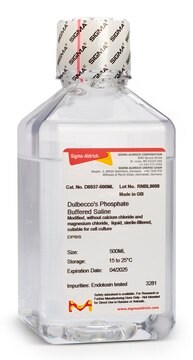Wichtige Dokumente
CHOK1
CHOZN® CHO K1 Host Cell Line
Suspension-adapted in CD media
About This Item
Empfohlene Produkte
Beschreibung
CHOK1 cell line derived from ECACC CHO K1
Qualitätsniveau
Versandbedingung
dry ice
Lagertemp.
−196°C
Allgemeine Beschreibung
Ursprung der Zelllinie
Physikalische Form
Rechtliche Hinweise
Lagerklassenschlüssel
10 - Combustible liquids
WGK
WGK 3
Flammpunkt (°F)
Not applicable
Flammpunkt (°C)
Not applicable
Hier finden Sie alle aktuellen Versionen:
Analysenzertifikate (COA)
Die passende Version wird nicht angezeigt?
Wenn Sie eine bestimmte Version benötigen, können Sie anhand der Lot- oder Chargennummer nach einem spezifischen Zertifikat suchen.
Besitzen Sie dieses Produkt bereits?
In der Dokumentenbibliothek finden Sie die Dokumentation zu den Produkten, die Sie kürzlich erworben haben.
Artikel
Understand how considerations such as DMSO concentrations and freezing techniques are key in the successful implementation of high cell density cryopreservation (HCDC).
Cellvento® and EX-CELL® CHO cell culture media and feeds, optimized for monoclonal antibody & recombinant protein production in fed-batch & perfusion
Verwandter Inhalt
Learn more about cell line development and the relevant products you need for this process.
This page describes the use of a small-scale perfusion bioreactor with integrated microfluidic flow control and sensor technologies to predict large-scale processes.
Enhance mAb and recombinant protein performance, efficacy, and stability with precise glycosylation modulation using the Cellvento® ModiFeed platform.
Active Filters
Unser Team von Wissenschaftlern verfügt über Erfahrung in allen Forschungsbereichen einschließlich Life Science, Materialwissenschaften, chemischer Synthese, Chromatographie, Analytik und vielen mehr..
Setzen Sie sich mit dem technischen Dienst in Verbindung.




